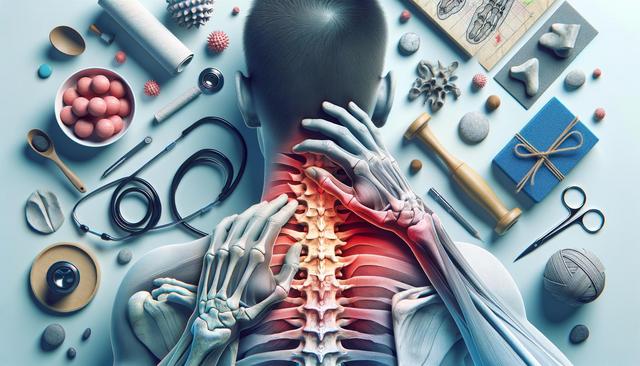Understanding the Root Causes of Arthritis Neck Pain
Arthritis in the neck, also known as cervical spondylosis, is commonly associated with age-related wear and tear of the spinal discs and joints. Over time, the cartilage that cushions the bones in the neck can degrade, leading to inflammation, stiffness, and discomfort. In cases of rheumatoid arthritis, the body’s immune system attacks the lining of the joints, causing chronic pain and limited movement. This degeneration not only impacts daily activities but can also contribute to recurring headaches and muscle tension. Knowing the causes and symptoms is essential for finding effective Chronic Neck Stiffness Solutions that improve daily life and prevent further joint damage.
Common symptoms of arthritis-related neck pain include:
- Persistent stiffness in the neck, especially after periods of inactivity
- Sharp or dull pain when turning the head
- Muscle spasms or tightness
- Headaches that originate at the base of the skull
- Numbness or tingling in the shoulders or arms
Recognizing these indicators early allows for timely intervention and integration of a supportive Home Routine for Neck Pain Relief.
Why Exercise Matters for Neck Arthritis Relief
While medication and physical therapy can help manage symptoms, regular movement is one of the most effective ways to combat neck arthritis. Carefully selected Exercises to Relieve Neck Pain can help improve posture, increase flexibility, and strengthen the muscles that support the cervical spine. Unlike high-impact activities, these exercises are generally gentle and can be adapted to varying levels of mobility, making them accessible for most people with chronic conditions.
Benefits of incorporating neck exercises include:
- Enhanced blood circulation to affected areas
- Reduced inflammation and stiffness
- Improved range of motion and flexibility
- Decreased frequency and intensity of headaches
When performed consistently, these exercises contribute to a long-term strategy for How to Get Rid of Neck Pain and Headache associated with arthritis. It’s important to consult a healthcare provider before starting any new routine, especially if neck pain is severe or accompanied by neurological symptoms.
Essential Exercises to Include in Your Home Routine
Creating a Home Routine for Neck Pain Relief doesn’t require a gym membership or specialized equipment. Many effective exercises can be performed while sitting or standing, using just body weight and proper technique. The following movements are gentle yet impactful for arthritis-related neck discomfort.
- Neck Tilts: Slowly tilt your head to one side, bringing the ear toward the shoulder. Hold for 5 seconds, then switch sides. Repeat 5–10 times.
- Chin Tucks: Gently pull your chin back to create a “double chin” effect, aligning the neck with the spine. Hold for 5 seconds and repeat 10 times.
- Shoulder Rolls: Roll your shoulders forward and backward in a circular motion to release tension in the upper back and neck area.
- Neck Rotations: Turn your head slowly from side to side, pausing briefly at each end of the motion. Avoid forcing the movement.
Adding these Exercises to Relieve Cervical Neck Pain into a daily routine can help reduce stiffness and support long-term joint health. Practicing deep breathing during these exercises may also enhance relaxation and pain relief.
Tips for Managing Neck Pain Beyond Exercise
While movement is essential, a comprehensive approach to arthritis neck pain relief includes multiple lifestyle adjustments. Complementary techniques and daily habits can further support joint function and reduce discomfort. Here are a few strategies that can be incorporated alongside your exercise program:
- Maintain Good Posture: Avoid slouching, especially when working at a desk or using a smartphone. Use ergonomic chairs and support pillows when needed.
- Apply Heat or Cold: Warm compresses can relax tight muscles, while cold packs may reduce inflammation.
- Stay Hydrated: Water supports joint lubrication and overall tissue health.
- Sleep Support: Choose a pillow that keeps the neck in a neutral position and avoid sleeping on your stomach.
These habits, when combined with Chronic Neck Stiffness Solutions like regular stretching and relaxation techniques, create a balanced approach to managing symptoms. For those dealing with persistent headaches, these lifestyle changes can also be part of a plan for How to Get Rid of Neck Pain and Headache through sustainable self-care.
When to Seek Professional Help
Although home-based remedies and exercises offer relief for many, it’s important to know when to consult a medical professional. If neck pain worsens or fails to improve with consistent care, a physician or physical therapist can offer further evaluation. Advanced imaging, diagnostic tests, or specialized treatments may be necessary in some cases.
Signs that indicate the need for professional support include:
- Persistent numbness or tingling in the arms or hands
- Difficulty with coordination or strength in the upper limbs
- Severe pain that disrupts sleep or daily activities
- Sudden increase in pain without an apparent cause
Seeking timely care not only helps identify the root cause but can also prevent complications. A medical provider may recommend specific Exercises to Relieve Cervical Neck Pain tailored to your condition or refer you to a specialist for more targeted therapies. Integrating professional guidance with a consistent Home Routine for Neck Pain Relief can significantly improve outcomes and quality of life.
Conclusion: Finding Relief Through Consistency and Care
Living with arthritis in the neck can be challenging, but with the right combination of movement, self-care, and professional support, it is possible to manage symptoms and improve well-being. By incorporating Exercises to Relieve Neck Pain into your daily life, adopting Chronic Neck Stiffness Solutions, and understanding How to Get Rid of Neck Pain and Headache through mindful habits, you can take proactive steps toward relief. Building a supportive Home Routine for Neck Pain Relief doesn’t require dramatic changes—just consistency, patience, and a willingness to listen to your body. Whether through stretching, posture changes, or occasional check-ins with a healthcare provider, small daily actions can make a meaningful difference in managing arthritis neck pain and restoring comfort.




Leave a Reply